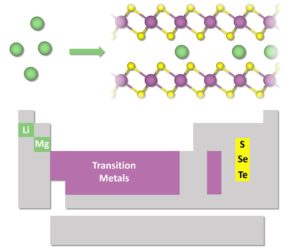
Congratulations to PGRs Conor Price and Edward Baker who have had their latest article ‘First principles study of layered transition metal dichalcogenides for use as electrodes in Li-ion and Mg-ion batteries’ published in the journal Journal of Materials Chemistry A.
Conor, first author on the publication, provides the following summary of the work and reflection on the process to publication:
The TMDCs are a group of layered structures that have found application in a wide range of fields, and here we investigated them to see if they could be used as intercalation electrodes in lithium-ion and magnesium-ion batteries. We evaluated a wide range of important material properties, including the voltages for each material, their reversible charge capacities, and the volumetric expansion that arises from charging and discharging.
With this investigation we have been able to offer insight into how the whole family of TMDCs behaves as intercalation electrodes, and layered materials in general. This provides a solid base from which these materials can be investigated further and allow for more novel structures such as superlattices and heterostructures to also be considered. We have also highlighted ScS2 in particular as a material which offers many properties that can compete with current market leaders. We hope this can be explored more to further battery research and development!
This piece of work has been a mammoth task and has formed the backbone of my PhD research, so it is a huge relief to finally have it out there.
Please see below for the abstract:
Abstract:
We present a first principles investigation of lithium- and magnesium-intercalation into each of the layered transition metal dichalcogenides. Using a consistent and thorough methodology, we investigate 84 TMDC materials (transition metals, Group XIV, and S, Se, Te chalcogens) as potential electrode materials, evaluating their T and H phases. We show generally low volume expansions and provide direct estimates of the theoretical capacity based on thermodynamic arguments. We find that many offer capacities in excess of 200 mA h g−1 (400 mA h g−1) with Li (Mg) intercalation and show a range of voltage profiles. For both Li and Mg, we show that the Group VIII and IX are promising electrode materials, and in particular highlight ScS2 as a promising cathode material. We also show that sulfides are generally better for electrode materials.

